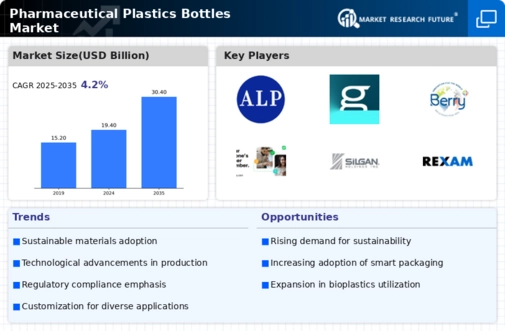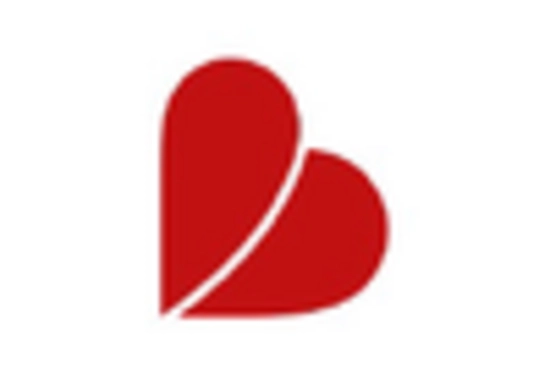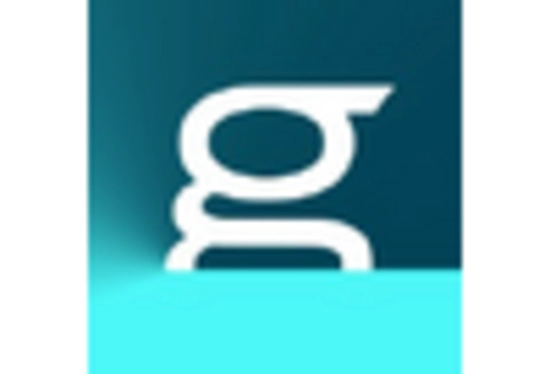Focus on Sustainability
Sustainability initiatives are gaining traction within the Pharmaceutical Plastics Bottles Market, as stakeholders increasingly prioritize environmentally friendly practices. The shift towards sustainable materials, such as bioplastics and recyclable options, is becoming a focal point for manufacturers. In 2025, it is anticipated that the market for sustainable packaging in pharmaceuticals will account for nearly 30% of the total packaging market. This trend indicates a growing awareness of environmental issues and the need for responsible packaging solutions. Companies that invest in sustainable practices are likely to enhance their brand reputation and appeal to environmentally conscious consumers, thereby influencing their market position within the Pharmaceutical Plastics Bottles Market.
Rising Demand for Pharmaceuticals
The Pharmaceutical Plastics Bottles Market is experiencing a notable surge in demand, primarily driven by the increasing prevalence of chronic diseases and the aging population. As healthcare systems evolve, the need for effective drug delivery systems becomes paramount. In 2025, the pharmaceutical sector is projected to grow at a compound annual growth rate of approximately 5.5%, which directly influences the demand for pharmaceutical packaging solutions. This growth is likely to propel the Pharmaceutical Plastics Bottles Market, as manufacturers seek to provide safe, reliable, and efficient packaging options that meet the needs of healthcare providers and patients alike. Furthermore, the expansion of biopharmaceuticals and personalized medicine is expected to further enhance the demand for specialized plastic bottles, thereby shaping the market landscape.
Innovations in Packaging Technology
Technological advancements play a crucial role in the Pharmaceutical Plastics Bottles Market, as innovations in packaging technology are continuously emerging. The introduction of smart packaging solutions, which incorporate features such as temperature control and tamper-evidence, is becoming increasingly prevalent. These innovations not only enhance product safety but also improve user experience. In 2025, it is estimated that the market for smart packaging in pharmaceuticals will reach a valuation of over 3 billion USD, indicating a significant shift towards more sophisticated packaging solutions. This trend suggests that manufacturers in the Pharmaceutical Plastics Bottles Market must adapt to these technological changes to remain competitive and meet the evolving demands of consumers and regulatory bodies.
Regulatory Pressures and Compliance
The Pharmaceutical Plastics Bottles Market is significantly influenced by regulatory pressures and compliance requirements. Governments and health authorities are increasingly implementing stringent regulations to ensure the safety and efficacy of pharmaceutical products. In 2025, it is expected that compliance costs for manufacturers will rise, as they must adhere to new guidelines regarding packaging materials and safety standards. This regulatory landscape compels companies to invest in high-quality materials and innovative packaging solutions that meet these requirements. Consequently, the Pharmaceutical Plastics Bottles Market may witness a shift towards more advanced materials that comply with safety regulations, thereby enhancing product integrity and consumer trust.
Growth of E-commerce in Pharmaceuticals
The rise of e-commerce is reshaping the Pharmaceutical Plastics Bottles Market, as online sales of pharmaceutical products continue to expand. The convenience of online shopping has led to an increase in demand for packaging that ensures product safety during transit. In 2025, it is projected that e-commerce sales in the pharmaceutical sector will account for over 20% of total sales, necessitating the development of robust and secure packaging solutions. This trend indicates that manufacturers must adapt their packaging strategies to cater to the unique challenges posed by e-commerce, such as longer shipping times and the need for tamper-proof designs. As a result, the Pharmaceutical Plastics Bottles Market is likely to evolve to meet these new demands, ensuring that products remain safe and effective throughout the distribution process.


















Leave a Comment